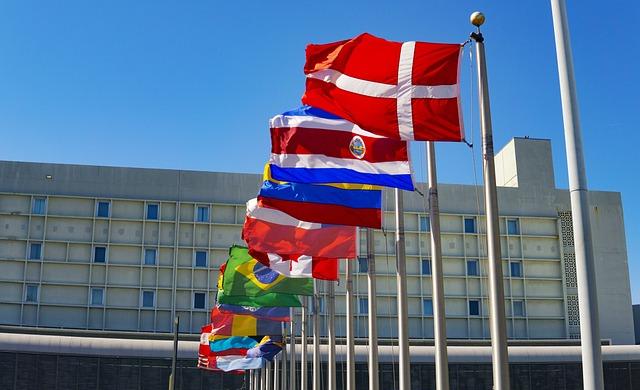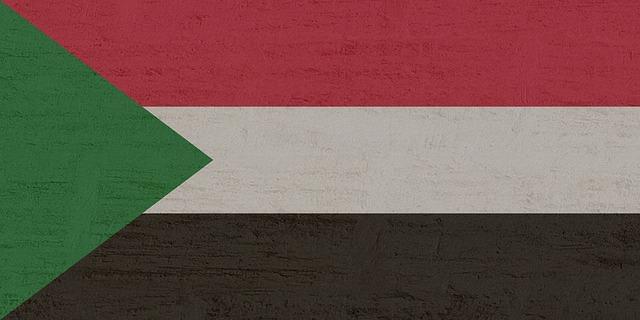In a meaningful progress aimed at addressing the urgent humanitarian crises in some of the world’s most challenged regions, the United Nations has announced a substantial $110 million aid package to support nations grappling with instability and conflict. among the primary beneficiaries are Sudan and Afghanistan, two countries that have faced prolonged turmoil and suffering. This new financial assistance seeks to provide critical resources and relief to millions of vulnerable individuals, highlighting the UN’s ongoing commitment to alleviating human suffering and fostering stability. As global attention increasingly turns to the escalating needs in these regions, this aid initiative underscores the international community’s responsibility to support those in dire circumstances while navigating the complexities of geopolitical dynamics. This article delves into the specifics of the aid distribution, the challenges faced by these nations, and the implications of this crucial funding for the future of their populations.
Sudan and Afghanistan Set to Receive Critical Humanitarian Aid from UN Initiative
In a significant humanitarian effort, the United Nations has announced a $110 million aid initiative aimed at addressing the urgent needs of vulnerable populations in Sudan and Afghanistan. These countries are grappling with multifaceted crises including political instability, food insecurity, and widespread poverty. As part of the initiative, various essential supplies and services will be deployed to support affected communities, helping to alleviate the dire conditions many families currently face. The UN aims to mobilize resources to improve access to healthcare, provide educational materials, and deliver much-needed food assistance.
The aid package will target critical areas, with a focus on enhancing safety and living conditions for civilians. In Sudan, millions are suffering from dire food shortages and health-related issues exacerbated by conflict, while Afghanistan experiences severe challenges as winter approaches. The UN has outlined several priority actions to ensure effective distribution and utilization of the funds:
- Emergency food supplies: Distribution of nutritional support to underserved regions.
- Healthcare provisions: Establishment of clinics and mobile health units.
- Education materials: Provision of school supplies and resources for displaced students.
| Country | Key Challenges | Aid Focus Area |
|---|---|---|
| Sudan | Conflict, food insecurity | Nutrition and Healthcare |
| Afghanistan | Political instability, poverty | Education and Shelter |

Analyzing the Immediate Impact of the $110 Million Funding on Regional Stability
The recent allocation of $110 million in UN aid is poised to deliver impactful changes in areas beset by conflict and humanitarian crises, notably in nations such as Sudan and Afghanistan. This infusion of funds is expected to enhance regional stability through critical support in various sectors. Key benefits of this funding may include:
- Enhanced Security Measures: Deployment of resources to bolster local law enforcement and community safety initiatives.
- food Security Programs: Addressing immediate hunger crises and enabling enduring agricultural practices.
- healthcare Accessibility: Strengthening health systems to provide critical services, especially in war-torn regions.
Moreover, the strategic implementation of this aid is crucial in alleviating immediate tensions and fostering a sense of hope among local populations. Engaging with grassroots organizations will ensure that the funding is utilized effectively, aligning with the needs of communities on the ground. The potential impact can also be illustrated in the following table, showcasing areas that may see significant benefits from the funding:
| Country | Sector of Impact | Expected Outcomes |
|---|---|---|
| Sudan | Food Security | Reduction in malnutrition rates |
| Afghanistan | Healthcare | Increased access to medical services |
| south sudan | Education | Improved literacy and school attendance |

Key Areas of Need: Health, Food Security, and Education in Beneficiary Nations
the recent infusion of $110 million in aid from the United Nations is set to address critical challenges faced by nations like Sudan and Afghanistan. These countries are grappling with dire conditions that have exacerbated issues related to health, food security, and education. In Sudan, the ongoing conflict has led to a collapse of health services, leaving many without access to basic medical care. coupled with the rampant inflation and rising food prices, food security has become a pressing concern, with millions facing starvation. The aid will play a vital role in restoring essential services, providing life-saving nutrition, and supporting healthcare systems struggling under the weight of increased demand.
In Afghanistan,the situation is equally alarming,with educational institutions disrupted by years of instability. The allocation of funds is expected to enhance school access and improve the quality of education for vulnerable children. Initiatives to promote nutrition and health education will also be implemented to bolster community resilience. Among the key areas targeted for support are:
- Healthcare facilities: Providing medical supplies and training healthcare workers.
- Emergency food distribution: Supplying immediate food relief and developing long-term agricultural support.
- Educational resources: Financing educational materials and teacher training programs.

Recommendations for Effective Distribution and Oversight of UN Assistance
To ensure effective distribution and oversight of UN assistance in countries like Sudan and Afghanistan,strategic frameworks must be established that promote transparency and accountability. Key recommendations include:
- Enhanced Monitoring Mechanisms: Implementing real-time tracking systems and audits to oversee fund allocation and usage.
- Local Partnerships: Collaborating with community-based organizations that have established trust and familiarity with local needs.
- Stakeholder Engagement: Involving beneficiaries in the planning and evaluation processes to ensure that aid directly addresses their requirements.
- Regular Reporting: Mandating quarterly performance reports that assess the outcomes of UN assistance and share these findings publicly.
Moreover,employing technology can substantially boost the efficiency of aid distribution. Leveraging mobile applications for feedback collection and utilizing blockchain for secure transaction tracking could revolutionize the oversight process. Additionally, an emphasis on capacity building within local governance structures can fortify the ability to manage aid effectively. Consider the following table highlighting essential technology tools:
| Technology Tool | Purpose |
|---|---|
| Mobile Feedback Apps | Streamline communication between aid providers and beneficiaries. |
| Blockchain Systems | Enhance the traceability and security of financial transactions. |
| Data Analysis Software | Analyze trends and outcomes to inform future interventions. |

Long-term Strategies for Sustained Development Beyond Immediate Aid
While immediate financial support is crucial for nations like Sudan and Afghanistan, the focus must also shift toward fostering long-term growth strategies that can sustain development beyond temporary aid packages. Prioritizing local empowerment through capacity-building initiatives can play a vital role. This includes investing in education and vocational training,which not only equips individuals with essential skills but also encourages entrepreneurship,thereby stimulating local economies. additionally, promoting inclusive governance and institutional resilience can help ensure that the benefits of aid are distributed fairly, reaching the most vulnerable populations.
To effectively transition from short-term relief to enduring progress, several key strategies should be considered:
- Building Infrastructure: Investing in roads, schools, and health facilities to strengthen the foundation of communities.
- Enhancing Agricultural Practices: Supporting sustainable farming techniques to boost food security and livelihoods.
- Fostering Public-Private Partnerships: Encouraging collaboration between governments and businesses to drive innovation and employment opportunities.
- Promoting Social Cohesion: Facilitating dialog among diverse community groups to enhance unity and cooperation.
such approaches not only provide immediate relief but also pave the way for a more stable and prosperous future. As seen in other regions, countries that successfully blend aid with sustainable strategies find themselves better equipped to navigate challenges, reducing reliance on external assistance over time.
| Focus Area | Description |
|---|---|
| Education | Developing curricula that reflect local needs and global trends. |
| Agriculture | Implementing climate-resilient farming methods. |
| Health | Improving access to essential healthcare services. |
| Infrastructure | creating robust transportation and energy systems. |

The Role of International Cooperation in addressing Ongoing Crises in sudan and Afghanistan
International cooperation plays a critical role in addressing ongoing crises in countries like Sudan and Afghanistan, where humanitarian needs have surged due to protracted conflict, economic instability, and natural disasters. The recent allocation of $110 million in assistance from the UN underscores the global commitment to mitigating suffering and restoring stability in these regions. Collaborative efforts among nations and international organizations enhance the effectiveness of response strategies, facilitating the provision of essential resources, medical support, and food aid to those in dire need. By joining forces,countries can pool their expertise,share best practices,and mobilize funds more efficiently.
Several key areas benefit particularly from international collaboration in these crises:
- Humanitarian Aid: coordinated distribution of food, shelter, and healthcare services to vulnerable populations.
- Capacity Building: Training local NGOs and goverment entities to ensure sustainable recovery and resilience.
- Political support: Diplomatic pressure and dialogue initiatives to foster peace agreements and stabilization efforts.
- Resource Mobilization: Collective fundraising and resource-sharing to meet the escalating financial demands of relief operations.
To illustrate the impact of international assistance, the following table highlights the distribution of aid across critical sectors in both countries:
| Sector | Sudan Aid Allocation | Afghanistan Aid Allocation |
|---|---|---|
| Food Security | $30 million | $25 million |
| Healthcare | $20 million | $15 million |
| Education | $10 million | $5 million |
| Protection Services | $5 million | $10 million |
Concluding Remarks
the recent announcement of $110 million in United Nations aid reflects a significant step towards addressing the pressing humanitarian crises in Sudan, Afghanistan, and several other nations. As ongoing conflicts and economic hardships continue to afflict these regions, this financial support aims to alleviate the suffering of vulnerable populations, providing essential services such as food, healthcare, and shelter. The commitment of the international community, as exemplified by this funding, underscores the urgent need for a collaborative response to global humanitarian challenges. As the situation evolves, it is imperative for stakeholders to ensure that these funds are effectively mobilized to bring about meaningful change, fostering resilience and stability for those in dire need. The road to recovery may be long, but this aid could serve as a crucial lifeline for countless individuals and families striving for a better future.

















